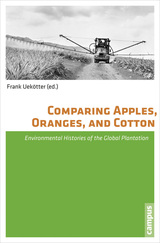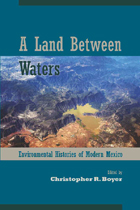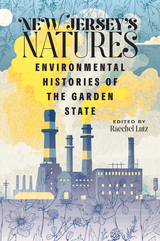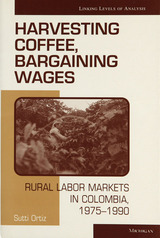4 books about Environmental Histories

Comparing Apples, Oranges, and Cotton
Environmental Histories of the Global Plantation
Edited by Frank Uekötter
Campus Verlag, 2014
Worldwide, plantations are key economic institutions of the modern era. From an environmental perspective, they are also the settings for some of the most powerful, consequential, and frequently destructive modes of production ever to have existed. This volume assembles essays on commodities as diverse as coffee, cotton, rubber, apples, oranges, and tobacco, to provide an overview of plantation systems from Latin America to New Zealand that exposes the many dimensions of environmental history incorporated in these robust institutions. The global history of plantation systems not only highlights the great institutional resilience of our modern monocultures, but also the price that humans and environments have paid for them.
[more]

A Land Between Waters
Environmental Histories of Modern Mexico
Edited by Christopher R. Boyer
University of Arizona Press, 2012
Mexico is one of the most ecologically diverse nations on the planet, with landscapes that range from rainforests to deserts and from small villages to the continent’s largest metropolis. Yet historians are only beginning to understand how people’s use of the land, extraction of its resources, and attempts to conserve it have shaped both the landscape and its inhabitants.
A Land Between Waters explores the relationship between the people and the environment in Mexico. It heralds the arrival of environmental history as a major area of study within the field of Mexican history. This volume brings together a dozen original works of environmental history by some of the foremost experts in Mexican environmental history from both the United States and Mexico.
The contributions collected in this seminal volume explore a wide array of topics, from the era of independence to the present day. Together they examine how humans have used, abused, and attended to nature in Mexico over more than two hundred years. Written in clear, accessible prose, A Land Between Waters showcases the breadth of Mexican environmental history in a way that defines the key topics in the field and suggests avenues for subsequent work. Most importantly, it assesses the impacts of environmental changes that Mexico has faced in the past with an eye to informing national debates about the challenges that the nation will face in the future.
A Land Between Waters explores the relationship between the people and the environment in Mexico. It heralds the arrival of environmental history as a major area of study within the field of Mexican history. This volume brings together a dozen original works of environmental history by some of the foremost experts in Mexican environmental history from both the United States and Mexico.
The contributions collected in this seminal volume explore a wide array of topics, from the era of independence to the present day. Together they examine how humans have used, abused, and attended to nature in Mexico over more than two hundred years. Written in clear, accessible prose, A Land Between Waters showcases the breadth of Mexican environmental history in a way that defines the key topics in the field and suggests avenues for subsequent work. Most importantly, it assesses the impacts of environmental changes that Mexico has faced in the past with an eye to informing national debates about the challenges that the nation will face in the future.
[more]

Nature Contained
Environmental Histories of Singapore
Timothy P. Barnard
National University of Singapore Press, 2014
How has Singapore’s environment—and location in a zone of extraordinary biodiversity—influenced the economic, political, social, and intellectual history of the island since the early 19th century? What are the antecedents to Singapore’s image of itself as a City in a Garden? Grounding the story of Singapore within an understanding of its environment opens the way to an account of the past that is more than a story of trade, immigration, and nation-building. Each of the chapters in this volume—focusing on topics ranging from tigers and plantations to trade in exotic animals and the greening of the city, and written by botanists, historians, anthropologists, and naturalists—examines how humans have interacted with and understood the natural environment on a small island in Southeast Asia over the past 200 years, and conversely how this environment has influenced humans. Between the chapters are travelers' accounts and primary documents that provide eyewitness descriptions of the events examined in the text. In this regard, Nature Contained: Environmental Histories of Singapore provides new insights into the Singaporean past, and reflects much of the diversity, and dynamism, of environmental history globally.
[more]

New Jersey's Natures
Environmental Histories of the Garden State
Raechel Lutz
Rutgers University Press, 2026
New Jersey’s Natures takes up the challenge of expanding academic and popular conceptions of New Jersey and its landscapes through the lens of environmental history. Scholars’ essays showcase the ways in which nature is integral to understandings of the state and its past as well as its future. These essays show that New Jersey should no longer solely be known as a place where pollution and suburbanization run amok, but rather a place where history happens.
The contributors investigate how nature and history are intertwined within this small but mighty state, covering topics from the colonial period to the present across North, South, and Central Jersey. They investigate natural features like the Delaware River and Bay, the Pinelands, and the unforgettable Jersey Shore. In this book you will find: indigenous Americans making meaning as settlers threaten their ways of life, Governor William Livingston considering Central Jersey’s features as he fights in the American Revolution, farmers building the state’s industrial agriculture, a foreign diplomat planting an arboretum, squatters in the swampy Meadowlands subverting social and economic norms, activists fighting for parks, forests, and beaches across two centuries, and much more.
The contributors investigate how nature and history are intertwined within this small but mighty state, covering topics from the colonial period to the present across North, South, and Central Jersey. They investigate natural features like the Delaware River and Bay, the Pinelands, and the unforgettable Jersey Shore. In this book you will find: indigenous Americans making meaning as settlers threaten their ways of life, Governor William Livingston considering Central Jersey’s features as he fights in the American Revolution, farmers building the state’s industrial agriculture, a foreign diplomat planting an arboretum, squatters in the swampy Meadowlands subverting social and economic norms, activists fighting for parks, forests, and beaches across two centuries, and much more.
[more]
READERS
Browse our collection.
PUBLISHERS
See BiblioVault's publisher services.
STUDENT SERVICES
Files for college accessibility offices.
UChicago Accessibility Resources
home | accessibility | search | about | contact us
BiblioVault ® 2001 - 2025
The University of Chicago Press









